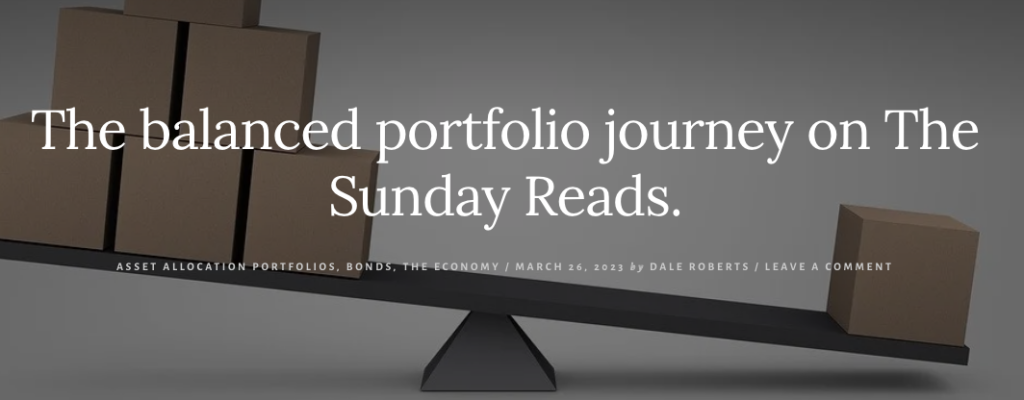By Dale Roberts, cutthecrapinvesting
Special to Financial Independence Hub
The balanced portfolio had a terrible 2022. In fact, it was just about the worst ever. Stocks were down and bonds had a rough ride delivering negative returns thanks to the rising yield environment. As rates go up, bond prices go down. Inflation was the culprit. Central bankers created a rising rate environment to cool the economy in the attempt to tame inflation. It was almost a year ago that I asked ‘what’s up with balanced portfolios in 2022’. Looking back on that post, things have played out as suggested in the post. And as a recession looks likely in 2023, bonds and the classic 60/40 balanced portfolio might be back in business. It’s the balanced portfolio journey on the Sunday Reads.
Here’s the post from April of 2022 – what’s up with balanced portfolios in 2022. At that point in time …
The stock and bond scorecard for 2022
- Canadian stocks are up 1.8%
- U.S. stocks are down 9.9%
- International developed markets are down 11.4%
- International emerging markets are down 13.9%
And when we looked at asset allocation ETFs, we saw that the more bond-heavy portfolios (top of that list) were down more than equity-heavy portfolios …
Here’s the year-to-date performance to April 21, 2022.
- XINC down 8.9%
- XCNS down 8.5%
- XBAL down 8%
- XGRO down 7.4%
- XEQT down 7.0%
And while this post covering the returns of the core ETF portfolios shows that the balanced portfolio model has worked quite well over the last several years, 2022 was a down year. A typical 60/40 portfolio was down about 11% in 2022.
The all-weather model was performing well, as I wrote …
There was nowhere to hide in the traditional balanced portfolio. That said if one took more of an all-weather portfolio approach the results would be far superior. In fact the portfolios I run for myself and my wife are very near all-time highs. An all-weather portfolio will include dedicated inflation protection by way of commodities, energy and commodity stocks, plus gold.
A key to managing a balanced portfolio is rebalancing on schedule, or rebalance when certain assets perform well as other assets floudner. We move monies from the winners to the losers. In the 2022 post I suggested …
The key with any balanced portfolio approach is to rebalance on schedule. Take your gains and move the assets to the asset that’s stinking the joint out. These days, that may mean taking profits from your inflation-fighters and Canadian stocks and moving them to the underperforming assets. Yes, even moving those profits to your bonds.
In anticipation of a recession, bonds have started to work again from late 2022, with more robust gains in the last 3 months.
Bonds? Well ya!
If you need to manage the portfolio volatility, you need to manage the portfolio volatility. Meaning, your risk tolerance did not change just because bonds are getting hurt. You still need to manage the risks.
During a stock market correction (and/or recession) bonds will be there to do their thing. That is, go up when stocks get crushed.
Also from that 2022 post …
If rates continue to go up, sure bond prices will continue to go down. But the bonds and bond funds will continually generate higher yields. Though, you will have to be patient. It can take a while in a core bond fund. If you want to manage the bond price risk, own bond funds with a shorter duration. They will go down less in price, and they can respond quicker in delivering the higher yields in a rising rate environment.
As a retiree think of cash and very short term bond funds as your store of value. The longer duration bond funds are there to offer that stock market shock absorber effect.
Bonds started to make more sense, delivering greater yields, with the potential of working as stock market shock absorbers.
Stocks are the unruly kids. Bonds are the adult in the room.
Ray Dalio thinks the economy is at a turning point. If we enter a recession, the U.S. market might not be a friendly place …
This will likely leave no sector unscathed, but the hardest hurt ones will likely be four out of the five in SPY’s portfolio (making up 57.77% of its total holdings): technology (26.23%), financials (12.71%), consumer cyclical (10.39%), and industrials (8.44%).
The financials and energy-heavy Canadian stock market is not well positioned for a recession, either.
That why for retirees and near retirees it might make sense to also consider the defensive sectors for retirement. They were twice as good in the last major recession. They can work in concert with bonds and cash.
And while I would guess that inflation stands a very good chance of being under control, I’m not going to invest based on that guess. I continue to hold those inflation fighters.
 Dale Roberts is the owner operator of the Cut The Crap Investing blog, and a columnist for MoneySense. This blog originally appeared on Cut the Crap Investing on March 26, 2023 and is republished on the Hub with permission.
Dale Roberts is the owner operator of the Cut The Crap Investing blog, and a columnist for MoneySense. This blog originally appeared on Cut the Crap Investing on March 26, 2023 and is republished on the Hub with permission.
Share this:
- Click to share on X (Opens in new window) X
- Click to share on LinkedIn (Opens in new window) LinkedIn
- Click to share on Facebook (Opens in new window) Facebook
- Click to share on Reddit (Opens in new window) Reddit
- Click to email a link to a friend (Opens in new window) Email
- Click to print (Opens in new window) Print


